Keywords
|
| superconducting fault current limiter,Distributed generation (DG) sources, microgrid, neighboring grid, protection devices, smart grid, |
INTRODUCTION
|
| The consumption of electrical energy has continually increasing and transmission and distribution organization has been more convoluted. For that causes, smart grid concept has been introduced, which could handle the consumption of electricity in real time and becomes more flexible, reliable than normal power systems [1]. In ac and dc microgrid, distribution and transmission infrastructure will best able to handle allowing for distributed generation such as wind turbines, photovoltaic (PV) farms and other electric power resources. Inspite of this, one important problem of these integrations is the large increase in a fault current because of the presence of distributed generation within ac and dc microgrid [2]. |
| Several routes from power plant to conventional grid, AC and DC microgrid, the large fault current in microgrid would affect the adjacent micro grid and it will be able to source a domino effect which leads a blackout finally. Therefore, smart grid could be protected by using smart power devices from increasing fault current and are essential for the reliability and the safe operation of power systems. In order to protect the smart grid having AC and DC microgrid from high fault currents, SFCL could be applied which has fast response time to reduce fault current by using quench properties of a superconductor compared to conventional protection devices. |
| The performance and location of AC SFCL in AC microgrid [4] and DC SFCL in DC micro-grid [5] have been examined. From the previous studies, this paper presents validity analysis results of location of SFCL and its effects on decreasing fault current in smart grid having AC and DC microgrid together. The entire power system was implemented with a low voltage dc grid connected with a photovoltaic farm and a microgrid having wind farm . Validity analyses were performed for the severe faults with the various SFCL locations. The dynamic location of SFCL in power grid, which could limit fault currents and a positive effect on the DG sources, is found to be the connection point of integration of the each DG sources in the microgrid. |
II. SIMULATION ARRANGEMENT
|
| Simulink/SimPowerSystem/MATLAB were beneficial electric power system analysis tools which has powerful graphical user interface and easy formation of coding using several blocks [6]. Using these simulation tools, the smart grid having three branches were designed and this power system configuration basically referenced to Korean electric power transmission and distribution networks. The fault current was determined at the output of wind farm, photovoltaic farm and substation respectively. Two cases of faults in AC and LVDC microgrid at 0.48 sec was generated respectively and the results were compared between 0.45sec. and 0.56sec. |
| A. Conventional Power Grid |
| A 100 MVA conventional power plant having three phase synchronous machine provides the electric power in the conventional power grid. The power from conventional power plant to the distribution grid is transmitted along 154 kV transmission line having a distance of 200km. Step down transformer was installed before the branch networks which reduce the voltage from 154 kV to 22.9 kV. The distribution network is separated into three branch networks: conventional power grid, AC and DC microgrid. |
| B. Microgrids |
| The microgrid has two grids AC microgrid and DC microgrid Each microgrid is integrated with distributed generation sources. AC microgrid has the wind farm which is having five fixed speed induction type wind turbine. Each wind turbine has a 2 MVA rating. The typical distribution voltage in Korea is 22.9kv so the working voltage of AC microgrid is 22.9 kV . |
| In DC microgrid, photovoltaic farm which consists of 500 solar panels are connected to the grid. the photovoltaic module has a 3 kW rating. The DC microgrid has a working voltage of 1.5 kV and this voltage was selected the operating voltage of LVDC. The prominent difference between AC and DC microgrid is the presence of voltage source convertor (VSC), pole mounted transformer (PMT) and domestic power convertor (DPC). |
| As indicated in Fig. 1, location 1 shows a single AC SFCL at the outgoing feeder of the substation transformer TR2. location 2 indicates two AC SFCLs at AC and DC microgrid. location 3 indicates both AC SFCL and DC SFCL at AC and DC microgrid respectively. Location 4 shows AC SFCL and DC SFCL at the outgoing feeder of the integration points of distributed generations. Location 5 indicates association of location 4 and a single AC SFCL at conventional power grid. |
| C. AC and DC SFCL Models |
| The three phase resistive type AC SFCL[7] model was designed considering six fundamental parameters and DC SFCL was modeled by eliminating RMS block and harmonic filters as indicated in Fig. b. The operation of both AC and DC SFCL is same. First, the flowing current RMS value was measured in SFCL characteristic table and then this RMS value was compared to the predetermined value of SFCL. Second, if the triggering current is lower than the passing current level, SFCL resistance increases to maximum impedance level in a predetermined response time. Finally, when the current level reaches below the triggering current level, the limiting mode stops working, and the system will go into normal state after recovery time. The total parameters are indicated in Table I. |
| A .Fault Current at the Output of Wind Farm When a Fault Occurred in AC Microgrid |
| Fig. 3 indicates the comparison of fault currents for different locations measured at the output of wind farm. When SFCLs was installed in location 1, 2 and 3, the magnitude of fault currents was high than that of No SFCL condition. This observance implies that SFCLs in location 1, 2 and 3 has no effect to reduce the fault current supplied from a wind farm. SFCLs installed in location 4 and 5 have shown the best fault current limiting performance because they were located in the direct path of the fault current present in AC microgrid. |
| B. Fault Current at the Output of Photovoltaic Farm When a Fault Occurred in AC Microgrid |
| Fig. 4 indicates the comparison of fault currents for different locations measured at the output of photovoltaic farm. When SFCL was installed in location 1, it has no effect to reduce the fault current in the distribution grid. Moreover, Photovoltaic farm contributed to enhance the fault current to adjacent AC microgrid. In case of SFCLs placed in location 2, 3, 4 and 5, it was possible to prevent the contribution of fault current from PV farm to adjacent AC microgrid. The best performance was obtained for SFCLs placed in all locations except location 1. |
| C. Fault Current at the Output of Substation Transformer When a Fault Occurred in AC Micro grid |
| Fig. 5 indicates the comparison of fault currents for different locations measured at the output of substation transformer. In this situation, the fault currents of all arrangements were lowered than No SFCL condition, because SFCL was located on the direct path from conventional power plant to the fault point in AC micro grid in all cases expect No SFCL case. By taking the magnitude of the fault current, Location 1, 4 and 5 has indicated the proper current limiting characteristics. But Location 1 could not decrease the increasing fault current caused by wind and photovoltaic farm because of the limits of current supply from conventional power plant. Therefore, SFCLs placed in location 1 could cause not positive effects on the another distributed generation sources. |
| D. Fault Current at the Output of Wind Farm When a Fault Occurred in DC Micro grid |
| Fig.6 indicates the comparison of fault currents for different locations measured at the output of wind farm. When a fault occurred, there is no lot of difference with No SFCL condition. This indicates that the fault in DC grid was not transferred to the adjacent AC grid because of the conversion process of the converter station [8]. So that the fault occured in DC microgrid as no influence on the wind farm in AC microgrid |
| E. Fault Current at the Output of Photovoltaic Farm When a Fault Occurred in DC Microgrid |
| The output of the photovoltaic farm at different locations, fault current was compared in Fig.7 . When SFCLs were installed in locations 1, 2 and 3, there is no lot of difference with No SFCL case. On the other side, SFCLs placed in Location 4 and 5 could limit the fault current instantly with positive effect because SFCLs are located in direct path of the fault point. So in location 4 and 5 SFCL shows the the best performance . |
| F. Fault Current at the Output of Substation Transformer When a Fault Occurred in DC Microgrid |
| The comparison of fault currents at different locations measured at the output of substation transformer shown in Fig.8.As stated earlier, fault occurred in DC microgrid has no serious effect on AC grid. So that there is no lot of difference between No SFCL and all other locations. |
| The effective position of SFCL for fault current reduction in case of a smart grid consisting of conventional power grid with AC microgrid and DC microgrid shown in Table.2. When SFCLs were placed in location 4 and 5, the fault current could be limited effectively. Due to these results, Location 4 and 5 could be the dynamic location of SFCLs to protect smart grid from increasing fault current. This indicates that the SFCL could be located on the direct path of current flowing from distributed generation resources both for AC and DC micro grids. Actually, Location 4 and 5 have no big difference in fault current limiting capabilities, but taking economic aspects, Location 4, which has less number of SFCLs, would be better solution for a smart grid |
IV. CONCLUSION
|
| This paper presented validity analysis results of location of the SFCL and its effects on reducing fault current in smart grid having AC and DC microgrid together. In order to determine the SFCL in adjacent AC and DC smart grid, AC and DC SFCL models were designed to perform for the worst case faults with the different SFCL Locations |
| From the simulation results, the optimal strategic installation placement of SFCLs in power systems, which limits all abnormal fault currents and has no negative effect on the distributed generation resources, has been proposed. SFCLs installed in Location 4 and 5 have shown the best fault current limiting performance because they are located in the direct path of the fault current occurred in AC and DC microgrid. Finally, due to no big difference in fault current limiting capabilities between Location 4 and 5, Location 4 has the less number of SFCLs would be better solution for a smart grid by considering economic aspects. |
Tables at a glance
|
 |
 |
| Table 1 |
Table 2 |
|
| |
Figures at a glance
|
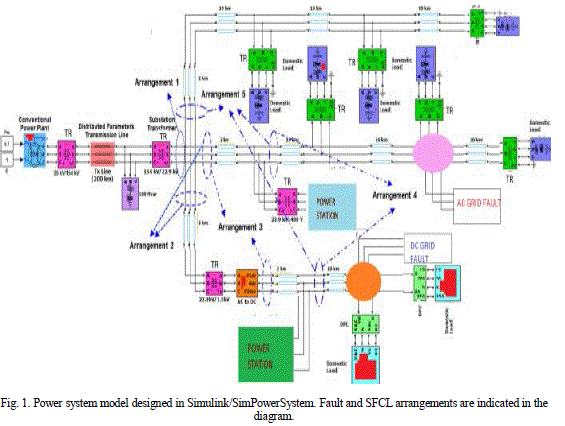 |
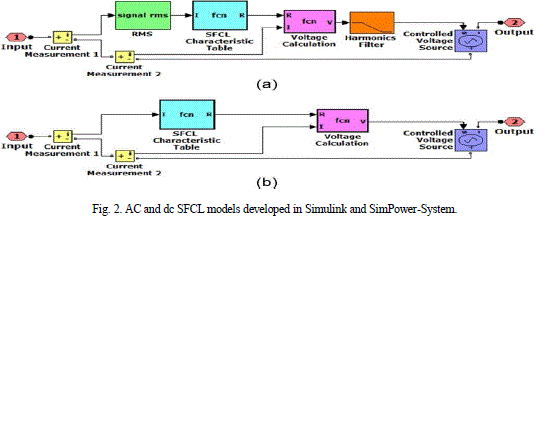 |
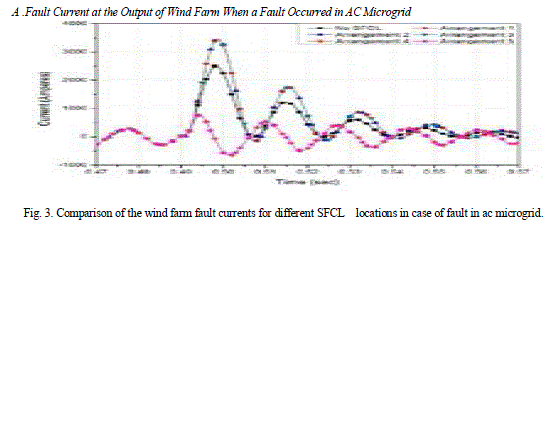 |
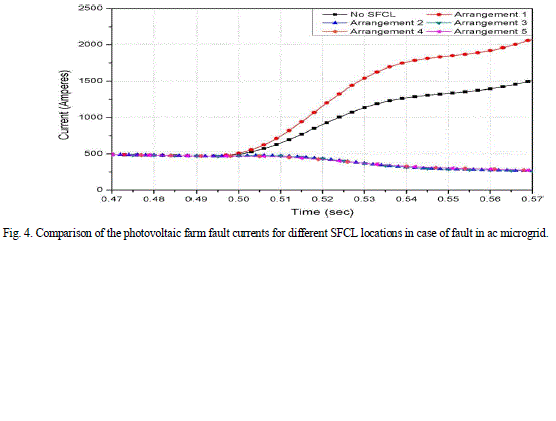 |
| Figure 1 |
Figure 2 |
Figure 3 |
Figure 4 |
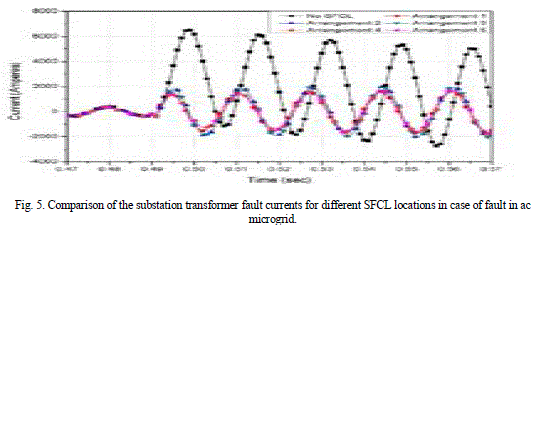 |
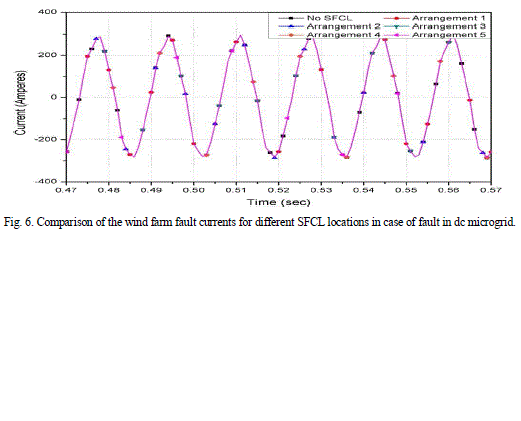 |
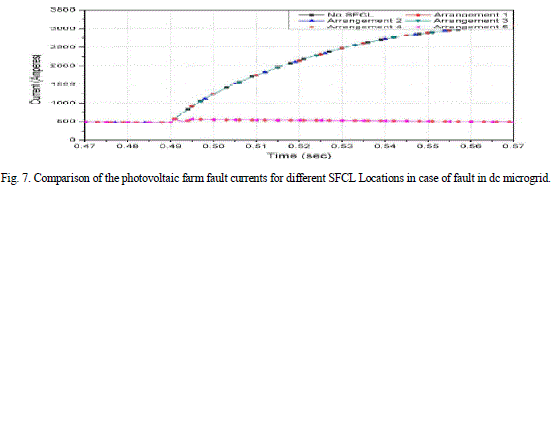 |
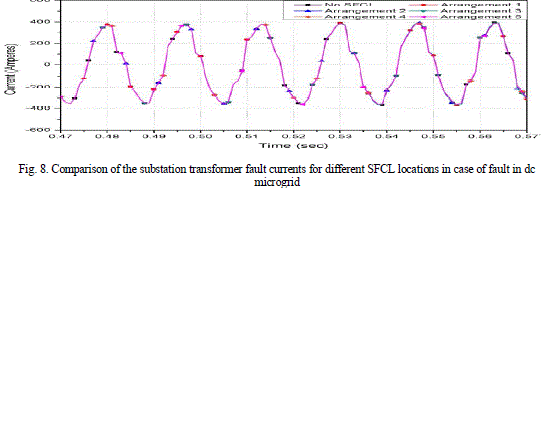 |
| Figure 5 |
Figure 6 |
Figure 7 |
Figure 8 |
|
| |
References
|
- R. Strzelecki and G. Benysek, Power Electronics in Smart ElectricalEnergy Networks. New York: Springer, 2008, pp. 8–9.
- J. Driesen, P. Vermeyen, and R. Belmans, “Protection issues in Microgrids with multiple distributed generation units,” in Proc. Power Convers.Conf.,Nagoya, Apr. 2007, pp. 646–654.
- T. Jamasb, W. J. Nuttall, and M. G. Pollitt, Future Electricity Technolo-gies and Systems. Cambridge, U.K.: Cambridge Univ. Press, 2006,pp. 235–246.
- U. A. Khan, W. J. Shin, J. K. Seong, and B. W. Lee, “Feasibility analysis of the application and positioning of DC HTS FCL in a DC micro grid through modeling and simulation using simulink and SimPowerSystem,” Phys. C .Adv. Supercond. XXIII, Sep. 2011.
- U. A. Khan, J. K. Seong, and B. W. Lee, “Feasibility analysis of the positioning of superconducting fault current limiters for the smart gridapplication using simulink and Simpowersystem,” IEEE Trans. Appl.Supercond., vol. 21, no. 3, Jun. 2011.
- L. Dessaint, K. Al-Haddad, H. Le-Huy, G. Sybille, and P. Brunelle, “A power system tool based on simulink,” IEEE Trans. Ind. Electron., vol. 46, no. 6, Dec. 1999.
- Y. Shirai, M. Taguchi, M. Shiotsu, H. Hatta, and T. Nitta, “Simulation study on operating characteristics of fault current limiter in one-machineinfinite bus power system,” IEEE Trans. Appl. Supercond., vol. 13, no. 2, Jun. 2003.
- D. Schmitt, Y. Wang, T. Weyh, and R. Marquardt, “DC-side fault current management in extended multiterminal-HVDC-grids,” in Proc. Int.Multi-Conf. Syst., Signals, Dev., 2012
|